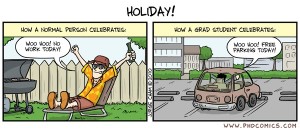Inspired by Martin Eve (link), I decided to make a documentation of academic-related stuff I’ve achieved in 2013. The last year was mostly occupado by the first year of my PhD, but other academic-ish stuff too as complimentary activities to research. This is kinda like a personal diary of ‘achievements’, as well as a documentation of the extent of work-procrastination. As such, please feel free not to share this with my supervisor 😉
The 12 days of PhD Christmas
Twelve Dinners Delivered (to the lab)
Eleven Papers Prepping
Ten Bugs-a-Bugging
Nine Ladies Dancing (but not with you)
Eight Bunsens-a-Burnin’
Seven Dance Solos
Six Words a Minute
Fiiive Grants Rejected
Four Calling Mates (“I’m busy“)
Three Absent Supervisors
Two Days off a Year (maybe)
And a h-index of nooought.

(source)
Merry Christmas everyone!
To bird or not to bird..
In 2012, the controversial case over whether or not Archaeopteryx lithographica, perhaps the most iconic dinosaur species of all time, was a bird was settled. Apparently. (free pdf) This was an important analysis for two reasons. Firstly, it countered a previous study showing that Archaeopteryx was more closely related to dinosaurs like Velociraptor and Deinonychus, and secondly used advanced, sort of non-traditional methods in palaeontology, called maximum likelihood and Bayesian analysis, to work out its relationships.
It’s been a while..!
In a post two months ago, I promised that I’d keep you updated with how my research is progressing. Needless to say, I’ve done a pretty poor job of that, unless you follow me on Twitter! I must apologise – the workload while travelling was severely under-estimated, and I’ve barely had time to catch a nap. I’m writing to you now from Lyon, where I finally had a day off in about a month to explore the Basilica and Roman amphitheater ruins here, and am now nestled in a snug pub hammering away at a manuscript!
